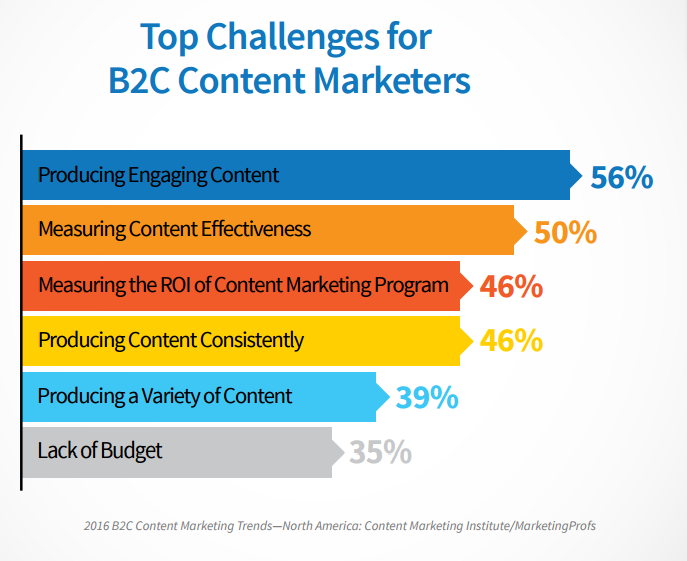
by Fronetics | May 17, 2016 | Blog, Content Marketing, Marketing, Strategy
Producing engaging content is the number one challenge for content marketers.
Is content marketing working well for your business? If not, you are not alone. Though it is one of the most effective ways to grow your business, content marketing has been challenging B2B and B2C organizations since its inception.
You may think it should be simple: Write, post, get more customers. But content marketing is much more complex, demanding more time, thought, and careful strategy than churning out a few blog posts. First and foremost, what you produce must engage readers. This is, however, the biggest content marketing challenge facing both B2B and B2C marketers.
2016 reports produced by Content Marketing Institute and MarketingProfs, and sponsored by Brightcove, found that the number one challenge for B2B and B2C marketers is producing engaging content.

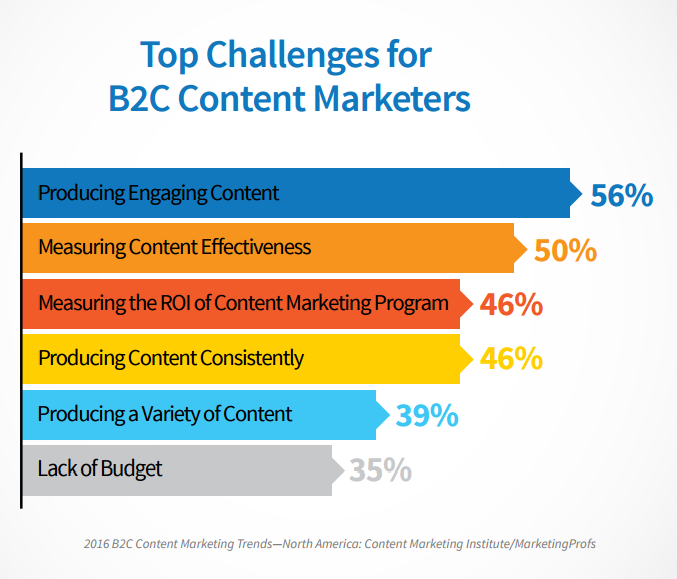
Dull content and the domino effect
Unfortunately, if you lack engaging content, it works like a domino, knocking down all your other marketing efforts.
For one, it is much easier to gain the support of the C-suite, and be granted a reasonable budget, for your content marketing plan if you can show that your strategy is attracting more customers, helping with conversions, and driving sales. But if your content is not producing results, you won’t get the support and resources you need to produce the content, which, in turn, fuels results. It is a vicious cycle.
That being said, lack of engaging, quality content may be indicative of other challenges you may be facing, like the resources to produce content.
Creating engaging content
There are a few basics you must address if you are going to produce engaging content:
- Research your customer demographic. You must know who your audience is, what they want to know, how they want to learn it, and where to find them. Use web analytics to learn how your audience interacts with your website, what kinds of posts and emails they are reading, and where improvements can be made.
- Do your due diligence and learn how to reach those potential customers with topical information they want and will read. This means conducting a solid analysis of trends in your industry and producing content that offers expert information on these subjects or answers pressing questions potential customers may have about them. You, thus, will establish your organization as a trusted voice for your industry. This leads to dialogue with prospects and customers that want to learn more from you about industry news — or, even better, who are interested in your products or services.
- Research your distribution channels. This can affect not only what you post, but where and when you post it. Know your target’s social media habits, when they read emails, and what they are looking for. Research your competition and learn which channels they focus their attention on and why. Read the latest industry publications and influential blogs to uncover what topics work to engage their readers. Look for trends and answer to them.
- Look at SEO evaluations and site audits to help identify new middle- and bottom-of-the-funnel opportunities for content.
- Tell a story.
If creating engaging content has proven to be challenging for your business, consider outsourcing your content creation, or your marketing program all together. According to Social Media Today, lack of marketing staff can make it difficult for organizations to produce enough content to keep up with their competition.
Quality research and consistent creation of engaging, relevant content is time-consuming and requires keen writing skills. Promoting your posts on social media also takes time and requires consistent effort. Some of the most successful organizations put this task in the hands of an expert that can create and leverage content to provide the greatest impact to your brand, lead generation, and new customer conversion rate.
Related posts:
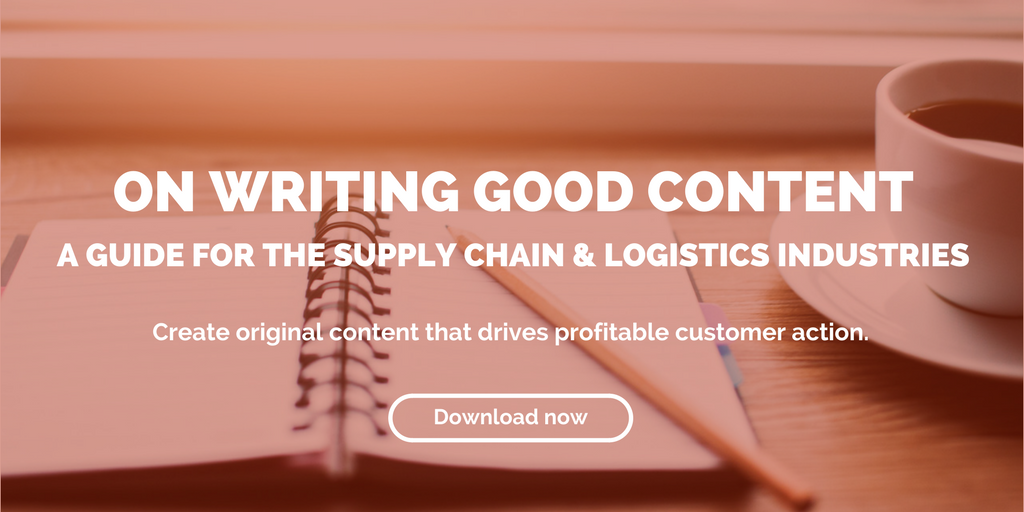
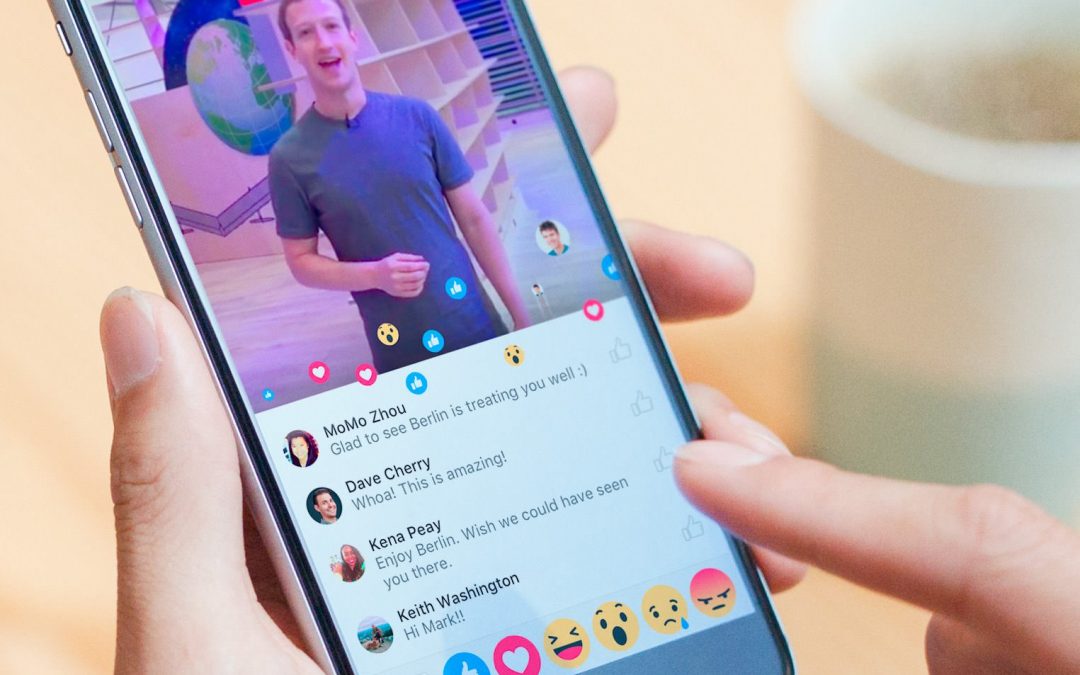
by Fronetics | May 12, 2016 | Blog, Content Marketing, Marketing, Social Media, Strategy
Facebook Live offers businesses a new, creative platform for engaging customers — here’s how to use it.
You may have noticed a sudden flurry of notifications on your Facebook account, alerting you to a new feature called Facebook Live. Facebook has slowly been rolling out Live since August 2015, making it available to all pages and profiles in December. And while it may be reminiscent of platforms like Snapchat and Periscope, which are popular social tools among America’s youngest users, this feature offers invaluable opportunities for businesses to reach customers in new and exciting ways.
Here is what B2B marketers need to know about Facebook Live.
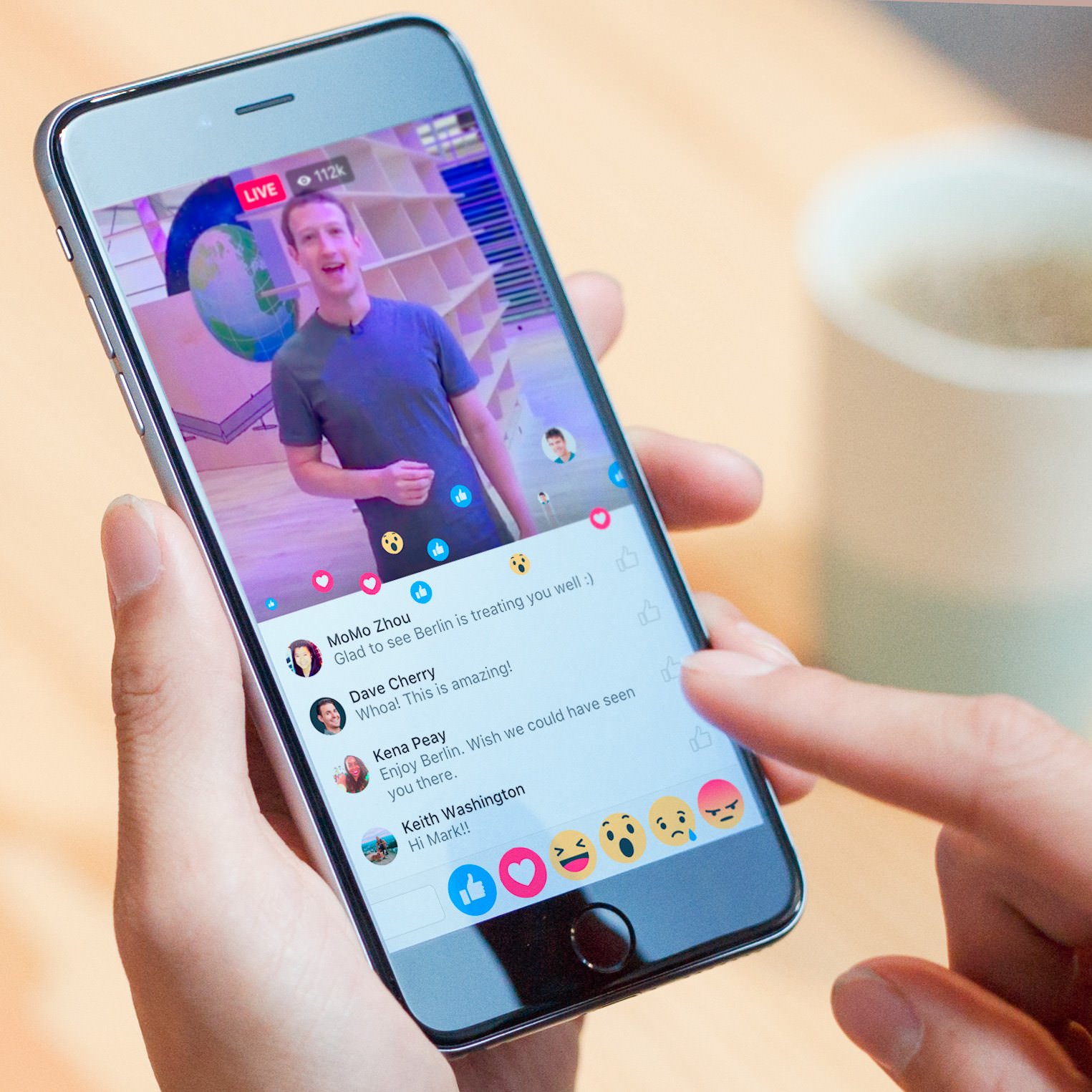 What is Facebook Live?
What is Facebook Live?
Facebook Live lets you broadcast in real time for up to 90 minutes at a time. People who have recently engaged (or who frequently engage) with your page will receive a notification that you are streaming live, and they can go to your page to view the video. Viewers can comment and react during the course of your broadcast, allowing you to read their remarks and respond immediately.
After the broadcast ends, the video will post on your timeline so those who missed it can watch it in full at a later time. You can edit or remove it, just like any other post, at any time.
Why is this good for business?
Video content is wildly popular. The number of videos uploaded to Facebook has increased by 94% over the last year, with more than 50% of Americans who use Facebook daily viewing at least one video per day. B2B businesses have caught on to this trend and have leveraged video quite successfully in their marketing efforts in the last year or two.
Facebook is an excellent forum for businesses to engage with customers, and Live can enhance this experience — or, at least, provide another avenue for doing so. There is something about being on air and uncensored that promotes transparency and offers the opportunity to connect with people in a very real way. Your business can showcase its brand personality, as well as its products and services, and offer high-value content to a wide audience through this channel.
Additionally, Live gets higher organic reach than non-live video, giving you a prominent spot in your followers’ feeds (without having to pay for it).
How does it work?
- Tap “What’s on your mind” at the top of your News Feed.
- Select “Live Video” from the drop-down menu.
- Add a description and choose your audience before hitting “Go Live.” You’ll see a three-second countdown before your broadcast begins.
Facebook offers these tips and best practices for using Live.
Note: Live is only available for iOS, Android, and Facebook Mentions.
Cool features
- Target a very specific audience by choosing location, language, gender or age.
- Choose where you broadcast live (other than your timeline) by posting to event pages and Facebook groups.
- A very prominent “Follow” button at the bottom of your broadcast allows your viewers to opt in to receive notifications when you go live in the future. Viewers can also invite friends to watch live videos with them.
- Edit your video after it posts to your timeline. You can select a thumbnail, select a category, include a URL, and add a call to action (such as Shop Now, Learn More, or Sign Up).
- Filters allow you to adjust the quality and color of your video, and soon a drawing tool will allow you to doodle over it.
- During your broadcast, you’ll see the number of live viewers, which friends are tuning in, and their comments in real time.
- Increase your reach by boosting the post after you’ve concluded your broadcast, or by creating a video ad from your broadcast by using the Ads Manager.
- The Live Map shows you where people are broadcasting around the world.
What kinds of content could B2B companies stream live?
Businesses have an incredible opportunity to engage with customers and partners with Facebook Live. Here are some ideas for the kinds of content your company could broadcast using this tool.
1) Behind-the-scenes glances
Show your audience your eco-friendly facilities, your impressive tradeshow set-up, your whiteboard after a strategic planning meeting, the inside of a fully packed delivery truck, a community service event, etc. There are a million creative ways to say something substantial about your business by offering a small glimpse into your day-to-day operations.
2) Q&As and Interviews
Live is an ideal platform for a Q&A-style broadcast. Invite customers to bring their questions or requests to a Live stream with one of your executives. Or, have a top-of-their-field expert offer insight on a particular topic or event.
3) Customer testimonials
Do you have any particularly happy customers who would be willing to speak about their experience working with your business? Or could someone on your team interview them? Not only is this great advertising for your company, it offers exposure for theirs as well.
4) How-tos, product demos, and sneak peeks
Build excitement for a product launch with previews, or demonstrate how to best use your product or service. Share your knowledge on best practices, tutorials, and processes related to your business.
5) Presentations, annual reports, celebrations, special events
Facebook Live offers a fresh way to present information or to share a special occasion with your online audience. Imagine announcing quarterly results this way, or honoring milestone employee anniversaries. This platform gives you a new format for marking such moments.
How does your company use Facebook Live?
Related posts:


by Fronetics | May 5, 2016 | Blog, Content Marketing, Marketing, Strategy

Speak your boss’ language with metrics, statistics, and facts that articulate content marketing’s impact on customer acquisition and sales.
Garnering C-suite support for your content marketing program can be a challenge. Your team knows that your strategy is working by evaluating a series of metrics (e.g., shares, website traffic, email click-through rates), but executives do not always understand the value of such measures. It is almost like marketers speak another language.
So, how do you articulate the value of content marketing in a way that your executives will understand and support? Think of it this way: It is like that scene in the movie Jerry Maguire, only it is your boss demanding, “Show me the money!” The C-suite wants to know the cost to the company and the dollar amount of the return for any marketing initiative you undertake. Basically, you need to quantify success in terms of customer acquisitions and new sales.
Don’t focus on the secondary results, or “soft” metrics like per-post Facebook engagement. Talk the C-suite’s language, and demonstrate how your content marketing efforts led to new customers and what those customers are worth to the company’s growth and success.
Report these six metrics to win C-suite support
- Customer Acquisition Cost (CAC): This is the total average cost your company spends to acquire a new customer. Basically, what your company spends in marketing costs, divided by the number of new customers it produced.
- Marketing Percentage of the CAC: This is the marketing department costs divided the costs of the sales and marketing costs to get the marketing percentage of overall cost per new customer. The figure demonstrates if more is going into the sales team or the marketing team to produce the current result, and the lower the percentage the better.
- Ratio of Customer Lifetime Value to CAC: This figure estimates the total value that your company derives from each customer versus what you spend to acquire them.
- Time to Payback CAC: This estimate demonstrates how many months it takes for your company to earn back the CAC it spent acquiring your new customers.
- Marketing-Originated Customer Percentage: This is where you look at all of the new customers from a set time period and determine what percentage of them started with a lead generated by your marketing team.
- Marketing-Influenced Customer Percentage: This figure highlights all of the new customers that marketing interacted with at the time they were still just leads.
Additional selling points for content marketing
Content marketing can make a big impact on your company in terms of spreading brand awareness, growing your audience, and helping form business relationships. Though these benefits are difficult to quantify, try using the following statistics and facts to articulate the value your program could have in a way your executives will understand.
- As any business knows, it is essential to be where you customers are, and they are online. Your competitors know this, too. In fact, a recent study indicated that that 77% of companies surveyed, across industries, had plans to increase their digital marketing budgets in the coming year.
- The B2B buying process has evolved, and now content is an essential tool for generating and nurturing leads. Reportedly, 88% of B2B marketers use content marketing as part of their programs, with lead generation (85%) and sales (84%) being the most important goals.
- Blog content has long-term value, as what you post today may continue attracting traffic months (or years) from now. Your posts last indefinitely, outliving more traditional marketing methods, such as a print advertisement in a magazine.
- Consistently publishing quality content can earn your company a reputation as a thought leader in your industry. The public will come to trust your company as a respected source of knowledge, and you’ll begin forming relationships with readers who want to know more about your products and services. People buy from companies that they trust and feel connected to.
- Content marketing will get you more bang for your buck. Results are not instant, but, with time, you can actually reduce your marketing expenses while increasing your reach and growing your business.
- Content marketing is a valuable business intelligence tool. By distributing content through social media platforms, you not only engage potential customers, but you get their feedback and learn more about their needs and wants.
For more on marketing metrics that will articulate success to your boss, download Fronetics Strategic Advisors’ tip sheet.
Related posts:
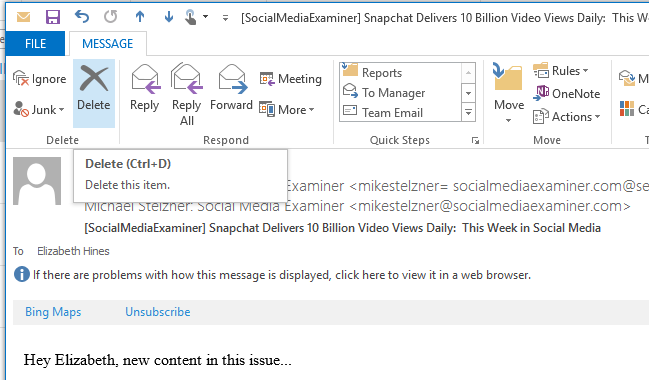
by Fronetics | May 3, 2016 | Blog, Content Marketing, Marketing, Strategy
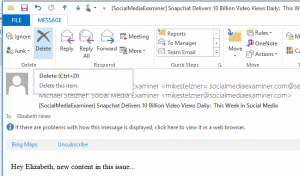
These tips will help you optimize your marketing emails to improve open rates.
Are you spending time creating marketing emails that nobody opens?
Today, everyone’s inbox is inundated with social media notifications, contests and giveaways, and marketing emails from every company they have even considered buying from in the last five years. How do you make your message stand out enough to not get deleted — let alone, read?
First and foremost, you must look at first-impression factors like subject lines, overall design, organization and formatting, and even when you are sending your emails.
For example, you may imagine potential customers sitting at their desks first thing each morning and going through emails, but that is not necessarily the case. Email marketing company Constant Contact finds that optimal open times vary widely by industry. But, truth be told, the best time for your business to send emails will be unique to your business — and the best way to know when is to test.
Another important factor to consider is how your potential customers are reading email. A recent Experian study found that 56% of email opens occur on a mobile device. If you send a marketing email that is not optimized for mobile, more than half of your recipients are straining and struggling to read your content. You’ve given them a good reason to delete it instead of reading it.
With these things in mind, how do you create marketing emails that potential customers will actually open and read? Here are a few basics:
Optimize what the recipient first sees.
Your sender name should be easily identifiable as coming from you, as this will influence if your reader opens your message.
Convey your point in the subject line.
Your subject line is the first thing your readers see and a major determinant in whether the recipient will open your email or hit delete. It should be short (under 70 characters so it does not get cut off), catchy, and attention-grabbing, but also to-the-point. Recipients should understand what the email is about without even opening it, but the subject line should hook them into wanting to know more.
Create a sense of urgency.
Give customers a reason to act quickly, rather than let the email sit in their inbox. Craft this sense of urgency within your subject line with some form of time limit or “what-you-must-know-now” phrasing.
Avoid words that label your email as spam.
Always avoid using words like “Cash,” “Quote,” and “Save.” Filters are designed to move emails with these words into spam.
Make it personal.
If the recipient is someone with whom you have done business or a potential customer that has signed up for newsletters or promotions, make it personal. Including their name makes the email feel conversational and almost rude if they don’t open it and at least see what you have to say to them. Studies show that personalized email subject lines increase open rates across industries by as much as 40%.
Certainly, open rates are not the only measure of success when it comes to marketing emails. But, to achieve your goals, it is vital to optimize the number of people who actually read your marketing message. Simply put, you cannot reach your audience unless you garner their interest quickly and get them to open up your message.
Related posts:

by Fronetics | May 2, 2016 | Blog, Content Marketing, Marketing, Social Media, Strategy, Supply Chain

Image credit: startbloggingonline.com
Here are three of the top benefits of social media for businesses in the supply chain and logistics industries.
We know that the majority of businesses participate in social media — in fact, a dominant 88% of B2B marketers report using these platforms as part of their marketing programs. Large corporations, small businesses, and those in between are promoting their brand and engaging with customers online. Even companies within the logistics and supply chain industries are joining the bandwagon and reaping the benefits of social media marketing.
The truth is, if your company is not participating in social media, you are at a disadvantage. Your customers, your employees, and your competitors are taking advantage of these technologies to conduct business in new, more efficient ways.
Why are so many companies using these tools?
Here are just three of the top benefits of social media for business:
1) Communicate and engage
By participating in social media, your business has at its fingertips a highly efficient, sophisticated platform for engaging customers, employees, potential hires, industry peers, and the general public. You can announce a new product launch; share small or sweeping changes in service, supplies, practices, locations, etc.; respond to questions or complaints; weigh in on industry discussions happening on online forums; and celebrate employee milestones and accomplishments.
2) Generate and nurture leads
Social prospecting is the process of using social technologies to identify and pursue potential customers that may be interested in your company but that don’t yet know about it. Your business can prospect from the 2.3 billion worldwide social media users, engage them with relevant content, and form and build relationships that you otherwise would have never encountered were it not for the World Wide Web.
3) Reduce marketing expenses
It’s free to set up social media accounts for your business. The real cost comes with dedicating resources to maintain and monitor the content on each channel, and those needs will vary from business to business. Even if you do chose to upgrade and pay for premium benefits and services, like ads, the cost is significantly lower than using many traditional mediums. One recent study suggests that the cost per thousand impressions (CPM) could be as low as $2.50, while traditional tactics, like direct mail ($57 CPM) and TV ads ($28 CPM), remain significantly higher.
Learn more about social media for business in Fronetics’ new white paper, Social Media and the Logistics and Supply Chain Industries. The paper defines social media and social technologies, identifies users and usage patterns, and describes more benefits companies within the logistics and supply chain industries can realize through participation.

Related posts:





 What is Facebook Live?
What is Facebook Live?




